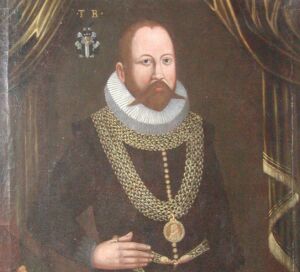Business & Education
The planet-gazer who was too polite to piss in Prague
This article is more than 9 years old.
The resulting urinary infection sent Uraniborg’s founder to the morgue

Brahe’s death is still shrouded in mystery (photo: Museum of National History at Frederiksborg Castle)
In November 2012, a Danish-Czech team of scientists released the results of their two-year investigation into the death of famed Danish astronomer Tycho Brahe, who died in suspicious circumstances in Prague over 400 years ago.
However, it was not the result the conpiracy theorists were expecting. A chemical analysis of Brahe’s exhumed remains indicated that they contained a normal level of mercury, disproving the popular myth that Brahe was poisoned.
Furthermore, tests on his prosthetic nose, something he chose to wear after it was cut off at the age of 20 in a fencing duel, indicated that it was not made of silver, as previously believed.
“Tycho Brahe didn’t die from mercury poisoning and he hadn’t taken any considerable doses of medicine that he could die from,” Jens Vellev, an Aarhus University scientist who led the study, told Jyllands-Posten newspaper last year. “The investigations surprisingly show that the prosthesis wasn’t made from precious metals. The tests did reveal equal traces of copper and zinc, suggesting instead that it was made of brass.”
READ MORE: Brahe myths are disproved, but secret remains buried
He refused to relieve himself
Despite two Brahe myths succumbing in one day, the shroud of mystery surrounding Brahe’s untimely demise while in exile in Prague continues to remain intact. But Vellev is leaning towards Brahe’s own written observations at the time.
“It states that Brahe attended a party at the [Holy Roman] emperor’s castle. They were drinking heavily and, out of politeness, Brahe refused to go to the toilet to relieve himself. He was struck with a fever and died eleven days later. That is essentially a urinary tract infection,” Vellev said, adding that he thought it doubtful that this could be proved using existing forensic technology.
It’s not the first time that scientists have attempted to get to the bottom of Brahe’s mysterious end. Brahe was exhumed for the first time in 1901 and scientists claimed to have found mercury in his hair, though they could not ascertain the amount at that time. This, though, contributed to the ill-deserved rumour of his mercury poisoning.
A friend on Ven
Born Tyge Ottesen Brahe in 1546, he lived what could only be described as an interesting life. A product of Danish nobility, he adopted the latinised name of Tycho Brahe at the age of 15.
Brahe was an astronomer, an alchemist, and one of the brightest scientific minds of the Renaissance. In 1572, he detected a new star in the constellation Cassiopeia, a shocking discovery at the time, given the prevailing notion that the heavens were perfect and unchanging. The following year, he became the first person to describe a supernova.
In 1576, King Frederik II gave Brahe the island of Ven in the Øresund Strait, where the astronomer built an elaborate castle that he named Uraniborg in honour of Urania, the Greek muse of astronomy. Here, Brahe built observatories and increasingly complex astronomical instruments and established Uraniborg as the best observatory in the whole of Europe.
A pisshead and a philanderer
Outside of his scientific contributions, he was, according to the physicist Herbert Dingle, an “indestructible blustering social being with an enormous appetite for food and wine”. Brahe also had an apparent appetite for a particular married woman – Queen Sophia, with whom Brahe is believed to have had a love affair and may have laid his own death trap.
When Sophia’s son, Christian IV, assumed the Danish throne following the death of King Frederik II, he was determined to exact revenge on the man suspected of invading his father’s marital bed. The young king deprived Brahe of his property and ordered Uraniborg to be torn down. The astronomer fled to Germany in 1597, settled in Prague, and died there four years later.
READ MORE: Rare painting of Tycho Brahe still missing
A long list of suspects
Suspicion that Brahe may have been murdered has persisted through the centuries, with some supposing the evil deed was committed by Brahe’s scientific rival Johannes Kepler. Other theories suggest Brahe may have accidently killed himself while dabbling in alchemy.
In 1991, Czech scientists removed hairs from the scientist’s moustache at the Prague National Museum and sent them to Denmark for testing. Results revealed a high concentration of mercury, and theories of foul play were reignited.
Among those who subscribed to the belief that Brahe was murdered was Professor Peter Andersen, a leading expert on Denmark’s Renaissance period. Speaking to the Copenhagen Post in 2010, Andersen lay the blame directly with Christian IV.
He claimed a close assistant of Christian IV arranged for Erik Brahe, a Swedish count and distant relative of the scientist, to poison the astronomer at the king’s behest. Andersen was able to obtain Erik Brahe’s personal diary and revealed its contents in 2008, claiming it laid out the details of the attack.
“I have described all the details about the murder,” Andersen said in a correspondence with the Copenhagen Post.
“However, for political reasons, the smallest Scandinavian monarchy is still refusing to face the truth, pretending to ignore irrefutable evidence about the king’s personal responsibility for the astronomer’s sudden death.”
Andersen even had a conspiracy theory about the 2010 exhumation.
“The main aim of the exhumation is to scan the scientist’s body in order to reconstruct him plastically and expose him in Denmark, most likely in the Tycho Brahe Planetarium,” he said.










































